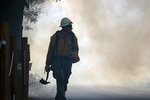
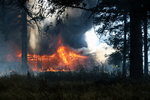
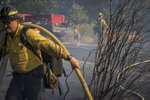
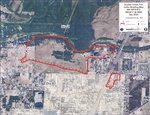
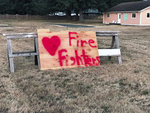
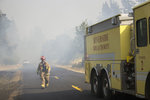
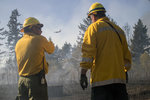
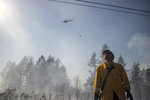
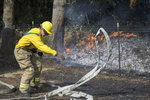
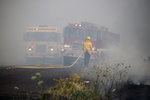
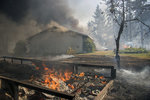
Kim Pollari just moved back into her Rochester home this month.
She and her husband had been living in a hotel since the fast-moving Scatter Creek wildfire surrounded their home on Aug. 22. There was smoke damage throughout the home, and everything inside had to be sent to a restoration company.
Now Pollari is stuck in the middle of a dispute between her insurance company and the restoration company, which charged $52,000 to clean the contents of her home and is now holding onto her stuff until it gets paid.
"We're basically camping out in my house," said Pollari, who fears the matter could lead to a costly court battle. "There's not much that we can do. Our hands are tied."
The 385-acre fire destroyed two homes, damaged others and burned more than a third of a state wildlife area. Those affected say they are still trying to rebuild.
The state's Department of Fish and Wildlife will hold a meeting this week to update the community on restoration efforts at the Scatter Creek Wildlife Area, parts of which were closed for a month after the fire. Meanwhile, a Department of Natural Resources report on the fire is expected to be released later this month.
A few streets over from Pollari, Karen Mork plans to rebuild on the site where her home burned down and her five cats died in the fire. For now, burnt debris is still strewn across the corner lot on Loganberry Street Southwest.
Mork said it has been hard to watch footage of much larger wildfires in California, of emergency responders driving through smoke and flames.
"That's what my neighbor and I were driving through. It brought it all back," she said.
Mork had hoped to be in her new home by January, but that has been pushed back to the end of March. ("It's mainly been paperwork, paperwork, and more paperwork.") Firefighters did manage to save a storage unit on the property. Mork thought it was filled with odds and ends destined for a yard sale, but inside she found boxes of photos and her mother's necklaces that she thought were lost.
The house across from Mork's also burned down, as did a landscape supply business up the street. Owner John de Aguiar said he was waiting on the fire report to file with his insurance company; he estimates he lost about $450,000 in equipment.
He said hauling and demolition work has kept him and his four employees going. He hopes to be ready in the spring when the landscaping business picks up.
'The fire was climbing up the trees...'
The Scatter Creek Wildlife Area is managed by the Department of Fish and Wildlife. Darric Lowery, the wildlife area manager, was off site the day he got the call that a fire had started on an adjacent property and had quickly moved onto the wildlife area.
He knew conditions were bad — high winds, low humidity, plenty of grass and vegetation that had grown up in the wet spring and dried out in the hot summer. By the time he got there, the fire was south of Scatter Creek and moving west toward the historic Miller-Brewer house and barn, which Fish and Wildlife used for office and storage space. Both burned down.
"The fire came through, the crews went running, the fire was climbing up the trees, these tall firs, 100 feet tall," Lowery said. "It moved pretty quickly at that point."
Scatter Creek is home to threatened and endangered species including the Mazama pocket gopher and Taylor's checkerspot and mardon skipper butterflies. It also is a popular spot for hunting, fishing, bird watching and dog training.
The state began acquiring the land in the 1960s; since the late 1990s it has worked intensively to fight off invasive species and restore the native prairie habitat, Lowery said. The fire burned more than a third of the wildlife area. Early estimates from Fish and Wildlife put the cost of restoring the land at more than $1 million.
Since then, crews have been removing burned trees and shrubs, seeding for native vegetation and trying to control the spread of invasive species, which can thrive post-fire because of the concentration of nutrients in the ash.
Lowery said he has heard from some in the community to just let nature take over. He said that would be a mistake.
"There's an investment that you make out there. We've invested not only for species and habitat but also recreation," he said. "Don't let it go to waste."